django之forms组件
在django中forms组件有其强大的功能,里面集合和众多的函数和方法:下面来看一下它的源码
"""
Form classes
""" from __future__ import unicode_literals import copy
from collections import OrderedDict from django.core.exceptions import NON_FIELD_ERRORS, ValidationError
# BoundField is imported for backwards compatibility in Django 1.9
from django.forms.boundfield import BoundField # NOQA
from django.forms.fields import Field, FileField
# pretty_name is imported for backwards compatibility in Django 1.9
from django.forms.utils import ErrorDict, ErrorList, pretty_name # NOQA
from django.forms.widgets import Media, MediaDefiningClass
from django.utils import six
from django.utils.encoding import force_text, python_2_unicode_compatible
from django.utils.functional import cached_property
from django.utils.html import conditional_escape, html_safe
from django.utils.safestring import mark_safe
from django.utils.translation import ugettext as _ from .renderers import get_default_renderer __all__ = ('BaseForm', 'Form') class DeclarativeFieldsMetaclass(MediaDefiningClass):
"""
Metaclass that collects Fields declared on the base classes.
"""
def __new__(mcs, name, bases, attrs):
# Collect fields from current class.
current_fields = []
for key, value in list(attrs.items()):
if isinstance(value, Field):
current_fields.append((key, value))
attrs.pop(key)
current_fields.sort(key=lambda x: x[1].creation_counter)
attrs['declared_fields'] = OrderedDict(current_fields) new_class = super(DeclarativeFieldsMetaclass, mcs).__new__(mcs, name, bases, attrs) # Walk through the MRO.
declared_fields = OrderedDict()
for base in reversed(new_class.__mro__):
# Collect fields from base class.
if hasattr(base, 'declared_fields'):
declared_fields.update(base.declared_fields) # Field shadowing.
for attr, value in base.__dict__.items():
if value is None and attr in declared_fields:
declared_fields.pop(attr) new_class.base_fields = declared_fields
new_class.declared_fields = declared_fields return new_class @html_safe
@python_2_unicode_compatible
class BaseForm(object):
# This is the main implementation of all the Form logic. Note that this
# class is different than Form. See the comments by the Form class for more
# information. Any improvements to the form API should be made to *this*
# class, not to the Form class.
default_renderer = None
field_order = None
prefix = None
use_required_attribute = True def __init__(self, data=None, files=None, auto_id='id_%s', prefix=None,
initial=None, error_class=ErrorList, label_suffix=None,
empty_permitted=False, field_order=None, use_required_attribute=None, renderer=None):
self.is_bound = data is not None or files is not None
self.data = data or {}
self.files = files or {}
self.auto_id = auto_id
if prefix is not None:
self.prefix = prefix
self.initial = initial or {}
self.error_class = error_class
# Translators: This is the default suffix added to form field labels
self.label_suffix = label_suffix if label_suffix is not None else _(':')
self.empty_permitted = empty_permitted
self._errors = None # Stores the errors after clean() has been called. # The base_fields class attribute is the *class-wide* definition of
# fields. Because a particular *instance* of the class might want to
# alter self.fields, we create self.fields here by copying base_fields.
# Instances should always modify self.fields; they should not modify
# self.base_fields.
self.fields = copy.deepcopy(self.base_fields)
self._bound_fields_cache = {}
self.order_fields(self.field_order if field_order is None else field_order) if use_required_attribute is not None:
self.use_required_attribute = use_required_attribute # Initialize form renderer. Use a global default if not specified
# either as an argument or as self.default_renderer.
if renderer is None:
if self.default_renderer is None:
renderer = get_default_renderer()
else:
renderer = self.default_renderer
if isinstance(self.default_renderer, type):
renderer = renderer()
self.renderer = renderer def order_fields(self, field_order):
"""
Rearranges the fields according to field_order. field_order is a list of field names specifying the order. Fields not
included in the list are appended in the default order for backward
compatibility with subclasses not overriding field_order. If field_order
is None, all fields are kept in the order defined in the class.
Unknown fields in field_order are ignored to allow disabling fields in
form subclasses without redefining ordering.
"""
if field_order is None:
return
fields = OrderedDict()
for key in field_order:
try:
fields[key] = self.fields.pop(key)
except KeyError: # ignore unknown fields
pass
fields.update(self.fields) # add remaining fields in original order
self.fields = fields def __str__(self):
return self.as_table() def __repr__(self):
if self._errors is None:
is_valid = "Unknown"
else:
is_valid = self.is_bound and not bool(self._errors)
return '<%(cls)s bound=%(bound)s, valid=%(valid)s, fields=(%(fields)s)>' % {
'cls': self.__class__.__name__,
'bound': self.is_bound,
'valid': is_valid,
'fields': ';'.join(self.fields),
} def __iter__(self):
for name in self.fields:
yield self[name] def __getitem__(self, name):
"Returns a BoundField with the given name."
try:
field = self.fields[name]
except KeyError:
raise KeyError(
"Key '%s' not found in '%s'. Choices are: %s." % (
name,
self.__class__.__name__,
', '.join(sorted(f for f in self.fields)),
)
)
if name not in self._bound_fields_cache:
self._bound_fields_cache[name] = field.get_bound_field(self, name)
return self._bound_fields_cache[name] @property
def errors(self):
"Returns an ErrorDict for the data provided for the form"
if self._errors is None:
self.full_clean()
return self._errors def is_valid(self):
"""
Returns True if the form has no errors. Otherwise, False. If errors are
being ignored, returns False.
"""
return self.is_bound and not self.errors def add_prefix(self, field_name):
"""
Returns the field name with a prefix appended, if this Form has a
prefix set. Subclasses may wish to override.
"""
return '%s-%s' % (self.prefix, field_name) if self.prefix else field_name def add_initial_prefix(self, field_name):
"""
Add a 'initial' prefix for checking dynamic initial values
"""
return 'initial-%s' % self.add_prefix(field_name) def _html_output(self, normal_row, error_row, row_ender, help_text_html, errors_on_separate_row):
"Helper function for outputting HTML. Used by as_table(), as_ul(), as_p()."
top_errors = self.non_field_errors() # Errors that should be displayed above all fields.
output, hidden_fields = [], [] for name, field in self.fields.items():
html_class_attr = ''
bf = self[name]
# Escape and cache in local variable.
bf_errors = self.error_class([conditional_escape(error) for error in bf.errors])
if bf.is_hidden:
if bf_errors:
top_errors.extend(
[_('(Hidden field %(name)s) %(error)s') % {'name': name, 'error': force_text(e)}
for e in bf_errors])
hidden_fields.append(six.text_type(bf))
else:
# Create a 'class="..."' attribute if the row should have any
# CSS classes applied.
css_classes = bf.css_classes()
if css_classes:
html_class_attr = ' class="%s"' % css_classes if errors_on_separate_row and bf_errors:
output.append(error_row % force_text(bf_errors)) if bf.label:
label = conditional_escape(force_text(bf.label))
label = bf.label_tag(label) or ''
else:
label = '' if field.help_text:
help_text = help_text_html % force_text(field.help_text)
else:
help_text = '' output.append(normal_row % {
'errors': force_text(bf_errors),
'label': force_text(label),
'field': six.text_type(bf),
'help_text': help_text,
'html_class_attr': html_class_attr,
'css_classes': css_classes,
'field_name': bf.html_name,
}) if top_errors:
output.insert(0, error_row % force_text(top_errors)) if hidden_fields: # Insert any hidden fields in the last row.
str_hidden = ''.join(hidden_fields)
if output:
last_row = output[-1]
# Chop off the trailing row_ender (e.g. '</td></tr>') and
# insert the hidden fields.
if not last_row.endswith(row_ender):
# This can happen in the as_p() case (and possibly others
# that users write): if there are only top errors, we may
# not be able to conscript the last row for our purposes,
# so insert a new, empty row.
last_row = (normal_row % {
'errors': '',
'label': '',
'field': '',
'help_text': '',
'html_class_attr': html_class_attr,
'css_classes': '',
'field_name': '',
})
output.append(last_row)
output[-1] = last_row[:-len(row_ender)] + str_hidden + row_ender
else:
# If there aren't any rows in the output, just append the
# hidden fields.
output.append(str_hidden)
return mark_safe('\n'.join(output)) def as_table(self):
"Returns this form rendered as HTML <tr>s -- excluding the <table></table>."
return self._html_output(
normal_row='<tr%(html_class_attr)s><th>%(label)s</th><td>%(errors)s%(field)s%(help_text)s</td></tr>',
error_row='<tr><td colspan="2">%s</td></tr>',
row_ender='</td></tr>',
help_text_html='<br /><span class="helptext">%s</span>',
errors_on_separate_row=False) def as_ul(self):
"Returns this form rendered as HTML <li>s -- excluding the <ul></ul>."
return self._html_output(
normal_row='<li%(html_class_attr)s>%(errors)s%(label)s %(field)s%(help_text)s</li>',
error_row='<li>%s</li>',
row_ender='</li>',
help_text_html=' <span class="helptext">%s</span>',
errors_on_separate_row=False) def as_p(self):
"Returns this form rendered as HTML <p>s."
return self._html_output(
normal_row='<p%(html_class_attr)s>%(label)s %(field)s%(help_text)s</p>',
error_row='%s',
row_ender='</p>',
help_text_html=' <span class="helptext">%s</span>',
errors_on_separate_row=True) def non_field_errors(self):
"""
Returns an ErrorList of errors that aren't associated with a particular
field -- i.e., from Form.clean(). Returns an empty ErrorList if there
are none.
"""
return self.errors.get(NON_FIELD_ERRORS, self.error_class(error_class='nonfield')) def add_error(self, field, error):
"""
Update the content of `self._errors`. The `field` argument is the name of the field to which the errors
should be added. If its value is None the errors will be treated as
NON_FIELD_ERRORS. The `error` argument can be a single error, a list of errors, or a
dictionary that maps field names to lists of errors. What we define as
an "error" can be either a simple string or an instance of
ValidationError with its message attribute set and what we define as
list or dictionary can be an actual `list` or `dict` or an instance
of ValidationError with its `error_list` or `error_dict` attribute set. If `error` is a dictionary, the `field` argument *must* be None and
errors will be added to the fields that correspond to the keys of the
dictionary.
"""
if not isinstance(error, ValidationError):
# Normalize to ValidationError and let its constructor
# do the hard work of making sense of the input.
error = ValidationError(error) if hasattr(error, 'error_dict'):
if field is not None:
raise TypeError(
"The argument `field` must be `None` when the `error` "
"argument contains errors for multiple fields."
)
else:
error = error.error_dict
else:
error = {field or NON_FIELD_ERRORS: error.error_list} for field, error_list in error.items():
if field not in self.errors:
if field != NON_FIELD_ERRORS and field not in self.fields:
raise ValueError(
"'%s' has no field named '%s'." % (self.__class__.__name__, field))
if field == NON_FIELD_ERRORS:
self._errors[field] = self.error_class(error_class='nonfield')
else:
self._errors[field] = self.error_class()
self._errors[field].extend(error_list)
if field in self.cleaned_data:
del self.cleaned_data[field] def has_error(self, field, code=None):
if code is None:
return field in self.errors
if field in self.errors:
for error in self.errors.as_data()[field]:
if error.code == code:
return True
return False def full_clean(self):
"""
Cleans all of self.data and populates self._errors and
self.cleaned_data.
"""
self._errors = ErrorDict()
if not self.is_bound: # Stop further processing.
return
self.cleaned_data = {}
# If the form is permitted to be empty, and none of the form data has
# changed from the initial data, short circuit any validation.
if self.empty_permitted and not self.has_changed():
return self._clean_fields()
self._clean_form()
self._post_clean() def _clean_fields(self):
for name, field in self.fields.items():
# value_from_datadict() gets the data from the data dictionaries.
# Each widget type knows how to retrieve its own data, because some
# widgets split data over several HTML fields.
if field.disabled:
value = self.get_initial_for_field(field, name)
else:
value = field.widget.value_from_datadict(self.data, self.files, self.add_prefix(name))
try:
if isinstance(field, FileField):
initial = self.get_initial_for_field(field, name)
value = field.clean(value, initial)
else:
value = field.clean(value)
self.cleaned_data[name] = value
if hasattr(self, 'clean_%s' % name):
value = getattr(self, 'clean_%s' % name)()
self.cleaned_data[name] = value
except ValidationError as e:
self.add_error(name, e) def _clean_form(self):
try:
cleaned_data = self.clean()
except ValidationError as e:
self.add_error(None, e)
else:
if cleaned_data is not None:
self.cleaned_data = cleaned_data def _post_clean(self):
"""
An internal hook for performing additional cleaning after form cleaning
is complete. Used for model validation in model forms.
"""
pass def clean(self):
"""
Hook for doing any extra form-wide cleaning after Field.clean() has been
called on every field. Any ValidationError raised by this method will
not be associated with a particular field; it will have a special-case
association with the field named '__all__'.
"""
return self.cleaned_data def has_changed(self):
"""
Returns True if data differs from initial.
"""
return bool(self.changed_data) @cached_property
def changed_data(self):
data = []
for name, field in self.fields.items():
prefixed_name = self.add_prefix(name)
data_value = field.widget.value_from_datadict(self.data, self.files, prefixed_name)
if not field.show_hidden_initial:
# Use the BoundField's initial as this is the value passed to
# the widget.
initial_value = self[name].initial
else:
initial_prefixed_name = self.add_initial_prefix(name)
hidden_widget = field.hidden_widget()
try:
initial_value = field.to_python(hidden_widget.value_from_datadict(
self.data, self.files, initial_prefixed_name))
except ValidationError:
# Always assume data has changed if validation fails.
data.append(name)
continue
if field.has_changed(initial_value, data_value):
data.append(name)
return data @property
def media(self):
"""
Provide a description of all media required to render the widgets on this form
"""
media = Media()
for field in self.fields.values():
media = media + field.widget.media
return media def is_multipart(self):
"""
Returns True if the form needs to be multipart-encoded, i.e. it has
FileInput. Otherwise, False.
"""
for field in self.fields.values():
if field.widget.needs_multipart_form:
return True
return False def hidden_fields(self):
"""
Returns a list of all the BoundField objects that are hidden fields.
Useful for manual form layout in templates.
"""
return [field for field in self if field.is_hidden] def visible_fields(self):
"""
Returns a list of BoundField objects that aren't hidden fields.
The opposite of the hidden_fields() method.
"""
return [field for field in self if not field.is_hidden] def get_initial_for_field(self, field, field_name):
"""
Return initial data for field on form. Use initial data from the form
or the field, in that order. Evaluate callable values.
"""
value = self.initial.get(field_name, field.initial)
if callable(value):
value = value()
return value class Form(six.with_metaclass(DeclarativeFieldsMetaclass, BaseForm)):
"A collection of Fields, plus their associated data."
# This is a separate class from BaseForm in order to abstract the way
# self.fields is specified. This class (Form) is the one that does the
# fancy metaclass stuff purely for the semantic sugar -- it allows one
# to define a form using declarative syntax.
# BaseForm itself has no way of designating self.fields.
forms源码
抛开其他的代码,我们之关注我们需要的东西
1 首先数据的验证通过的是is_vaild方法,它下面有以下东西
return self.is_bound and not self.errors 对照以下也就是is_bound不能为空,并且 errors方法返回的为空,则通过验证
2 我们找到 errors 方法,
@property
def errors(self):
"Returns an ErrorDict for the data provided for the form"
if self._errors is None:
self.full_clean() #找到full_clean
return self._errors
3 找到 full_clean 方法
def full_clean(self):
"""
Cleans all of self.data and populates self._errors and
self.cleaned_data.
"""
self._errors = ErrorDict() #先赋一个空的错误字典
if not self.is_bound: # Stop further processing.
return
self.cleaned_data = {} #定义一个空的cleaned_data字典
# If the form is permitted to be empty, and none of the form data has
# changed from the initial data, short circuit any validation.
if self.empty_permitted and not self.has_changed():
return
#执行下面三种方法
self._clean_fields()
self._clean_form()
self._post_clean()
4 找到 _clean_fields 方法
def _clean_fields(self):
for name, field in self.fields.items(): #依次遍历字段
# value_from_datadict() gets the data from the data dictionaries.
# Each widget type knows how to retrieve its own data, because some
# widgets split data over several HTML fields.
if field.disabled:
value = self.get_initial_for_field(field, name)
else:
value = field.widget.value_from_datadict(self.data, self.files, self.add_prefix(name))
try:
if isinstance(field, FileField):
initial = self.get_initial_for_field(field, name)
value = field.clean(value, initial)
else:
value = field.clean(value)
self.cleaned_data[name] = value #通过自定义和django里面定义的方法后,将它加入到 cleand_data字典中
if hasattr(self, 'clean_%s' % name): #判断是否有自定义的局部钩子函数
value = getattr(self, 'clean_%s' % name)() #通过了局部钩子则返回数据
self.cleaned_data[name] = value #将数据加入 cleaned_data
except ValidationError as e:
self.add_error(name, e) #错误的话执行 add_error
5 找到add_error
self._errors[field].extend(error_list) #将错误信息加入 _errors
if field in self.cleaned_data:
del self.cleaned_data[field] #删除cleaned_data中这条数据,之前是通过自定义方法加入的,通不过 钩子函数
6 回到上面执行 self._clean_form()
def _clean_form(self):
try:
cleaned_data = self.clean() #接着执行 clean()全局钩子
except ValidationError as e:
self.add_error(None, e)
else:
if cleaned_data is not None:
self.cleaned_data = cleaned_data
7接着查看 全局钩子 clean ,它只有一个返回的数据,因此我们可以自定义一个
def clean(self):
return self.cleaned_data #注意返回的数据和局部钩子的区别
8 最后查看 _post_clean ,说白了就是什么都没有
def _post_clean(self):
pass
以上是源码内部执行的顺序,下面我们来看一个例子
1 自定义判断字段
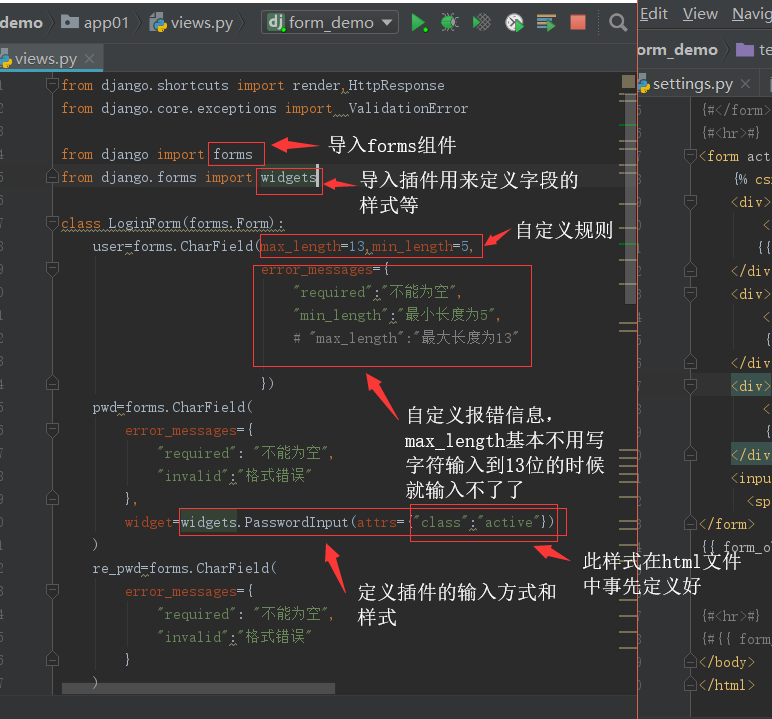
2 自定义局部钩子

3自定义全局钩子

4 继承并使用
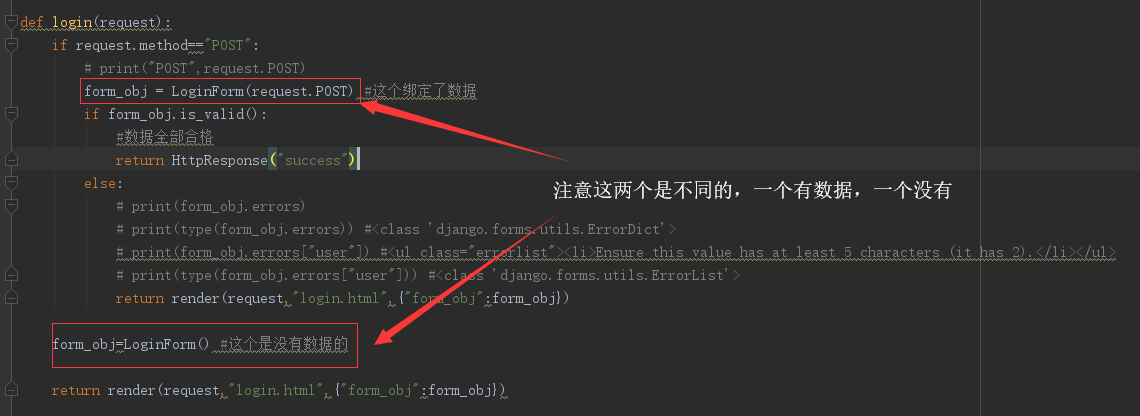
5 .1在模板中显示一

上面的代码 form_obj.errors.all_error 也可以改成 {{ form_obj.non_field_errors.0 }}
5.2 在模板中显示二
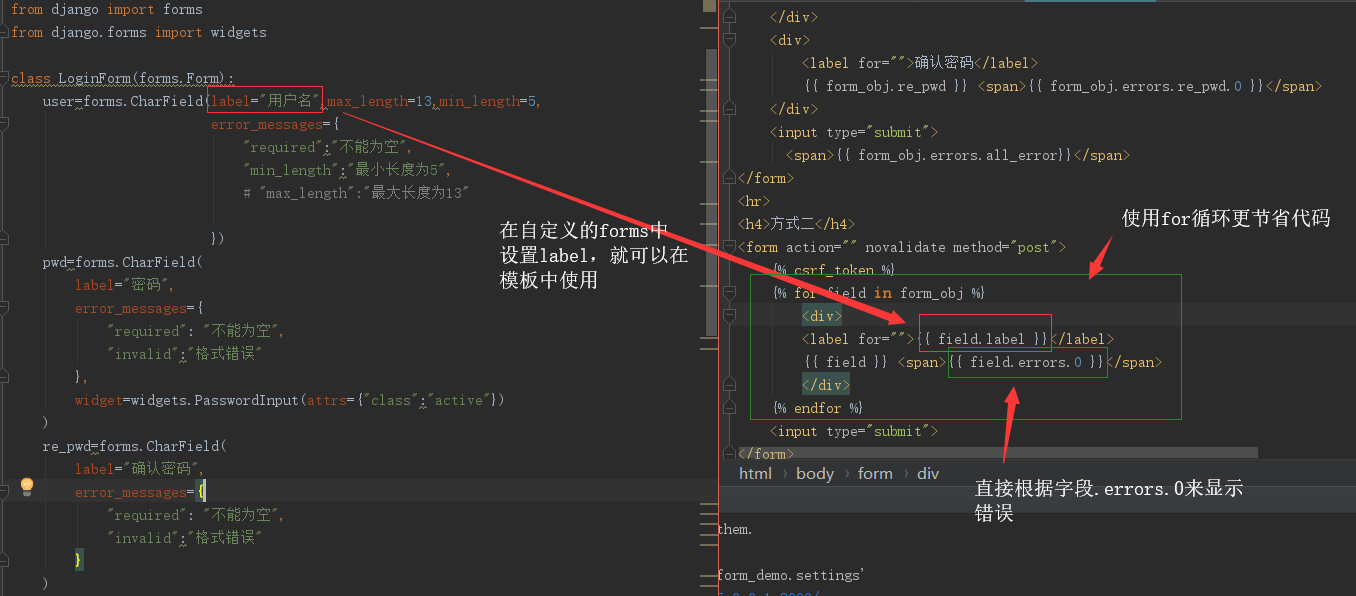
6在浏览器上面看效果
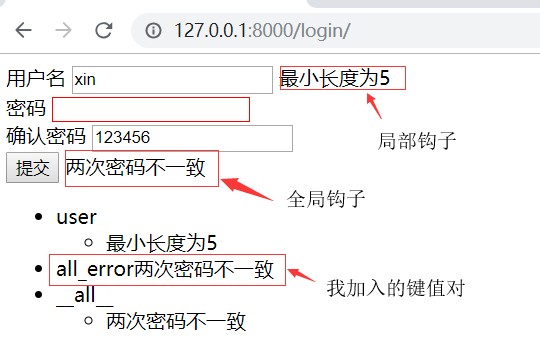
其他:
我们在forms组件中处理的不同情况
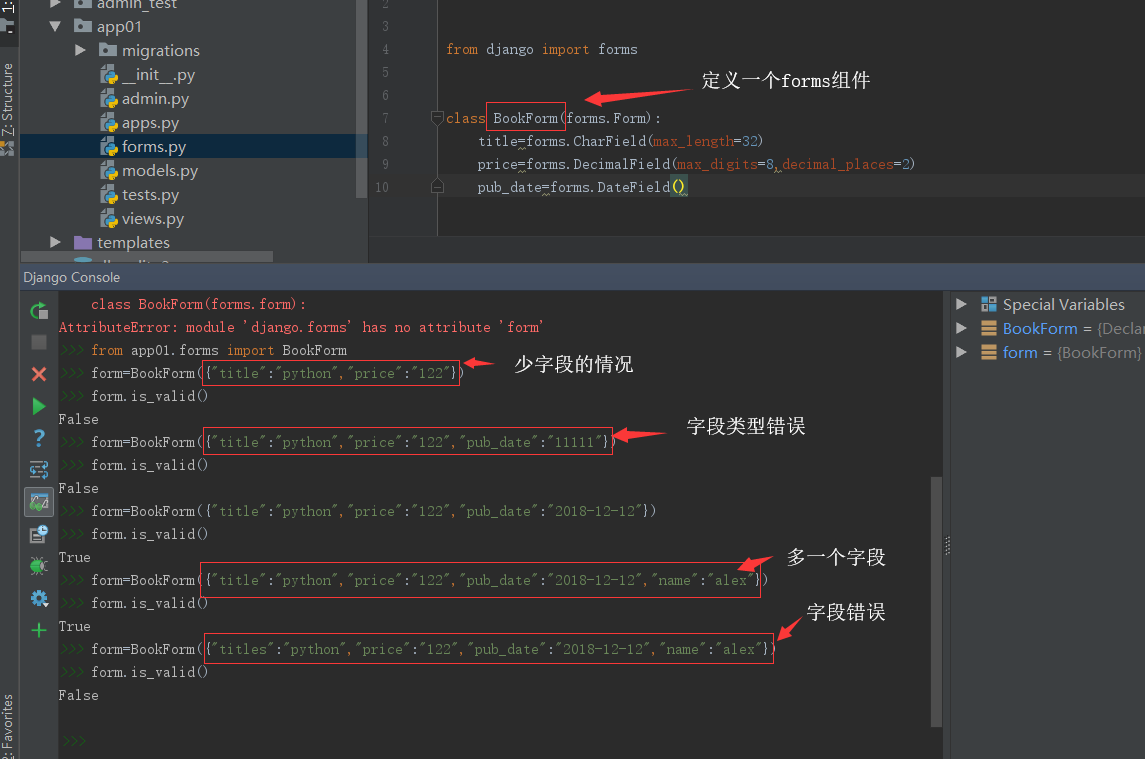
django之forms组件的更多相关文章
- web框架开发-Django的Forms组件
校验字段功能 针对一个实例:用户注册. 模型:models.py class UserInfo(models.Model): name=models.CharField(max_length=32) ...
- Django之forms组件使用
注册功能 1.渲染前端标签获取用户输入 >>> 渲染标签 2.获取用户输入传递到后端校验 >>> 校验数据 3.校验未通过展示错误信息 >>> 展 ...
- Django之forms组件进阶
Django Form表单组件 Form介绍 我们之前在HTML页面中利用form表单向后端提交数据时,都会写一些获取用户输入的标签并且用form标签把它们包起来. 与此同时我们在好多场景下都需要 ...
- django之forms组件,cookie&session
forms组件 先自己实现注册功能,并且对用户输入的信息加限制条件如果用户输入的信息不符合条件,前端展示报错信息 from django.shortcuts import render,HttpRes ...
- Django学习之八:forms组件【对form舒心了】
目录 Django forms组件 bound and unbound form instance forms渲染有关 隐藏一个字段,不渲染它 form 校验 form类 ModelForm 利用Mo ...
- Django组件-Forms组件
Django的Forms组件主要有以下几大功能: 页面初始化,生成HTML标签 校验用户数据(显示错误信息) HTML Form提交保留上次提交数据 一.小试牛刀 1.定义Form类 from dja ...
- django的forms认证组件
django的forms认证组件 每个网站的注册界面都需要有相应的"认证"功能,比如说认证注册页面的用户名是否已被注册,二次输入的密码是否一致以及认证用户输入的用户名.邮箱.手机号 ...
- 08 Django组件-Forms组件
Django的Forms组件主要有以下几大功能: 页面初始化,生成HTML标签 校验用户数据(显示错误信息) HTML Form提交保留上次提交数据 一.小试牛刀 1.定义Form类 from dja ...
- Django组件--forms组件(注册用)
一.forms组件--校验类的使用 二.form组件--校验类的参数 三.forms组件校验的局部钩子--自定义校验规则(要看源码理解) 四.forms组件校验的全局钩子--校验form表单两次密码输 ...
随机推荐
- 2018.5.8 python操纵sqlite数据库
创建: create_Email = "CREATE TABLE if not exists emails (\n\ id INTEGER NOT NULL,\n\ user VARCHAR ...
- About cookie
1.cookie 是一种发送到客户浏览器的文本串句柄,并保存在客户机硬盘上,可以用来在某个WEB站点会话间持久的保持数据. 2.session其实指的就是访问者从到达某个特定主页到离开为止的那段时间. ...
- 加密算法HASH和MD5模块hsahlib
HASH Hash,一般翻译做"散列",也有直接音译为"哈希"的,就是把任意长度的输入(又叫做预映射,pre-image),通过散列算法,变换成固定长度的输出, ...
- Automated EBS Snapshots using AWS Lambda & CloudWatch
Overview In this post, we'll cover how to automate EBS snapshots for your AWS infrastructure using L ...
- Yii2 设计模式——设计模式简介
我们首先来思考一个问题:作为工程师,我们的价值是什么? 笔者认为是——解决用户问题. 我们的任何知识和技能,如果不能解决特定的问题,那么就是无用的屠龙之术:我们的任何经验,如果不能对解决新的问题有用, ...
- ActiveMQ (三)—持久化消息
ActiveMQ的另一个问题就是只要是软件就有可能挂掉,挂掉不可怕,怕的是挂掉之后把信息给丢了,所以本节分析一下几种持久化方式: 一.持久化为文件 ActiveMQ默认就支持这种方式,只要在发消息时设 ...
- input框在浏览器上显示一个叉,去掉方法
/* 清除IE10及以上版本input的叉叉(X)和密码输入框的眼睛图标 */ input::-ms-clear { display: none; } input::-ms-reveal { disp ...
- Windows2008 R2 X64 PHP环境搭建步骤
Windows2008 R2 X64 PHP环境搭建步骤: 下载:Mysql5.7.23.PHP5.6.Zend.XCahe 一.安装MYSQL.导入数据: 解压MYsql压缩包,并新建Data目录, ...
- 工控随笔_18_西门子_WinCC的VBS脚本_07_变量作用域和传值、传址
在vbs脚本中也存在和其他编程语言一样的概念,那就是变量的作用域,变量的作用域决 定在什么范围内可以访问. 同样的在vbs脚本中对于变量也有一个生命周期, 变量的生命周期决定了变量的存续时间 这个主要 ...
- windows下的端口转发命令netsh
使用下面的命令查看语法 netsh interface portproxy add v4tov4 /? add v4tov4 [listenport=]<integer>|<serv ...
